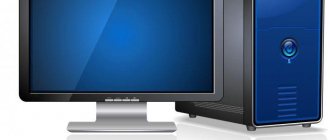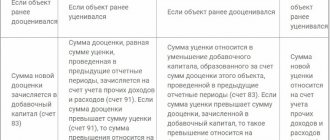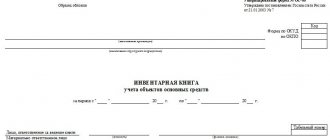Fixed assets in accounting
Fixed assets are material assets that are planned to be used to carry out the activities of the institution for at least 12 months.
Moreover, in the process of recognizing fixed assets in accounting, its value does not play any role. In 2020, public sector employees are required to maintain asset accounting according to the new federal standard. We talked about the key changes that are regulated by this regulatory legal act in the article “Understanding the new accounting standards.”
Synthetic and analytical accounting of fixed assets in a budgetary institution is carried out on account 0 101 00 000. Accounting objects are included in the balance sheet of the organization at their original cost:
- if the cost of fixed assets is up to 10,000 rubles - it is considered to be of low value and is recorded on off-balance sheet accounts;
- when assessed up to 100,000 rubles, but more than 10,000 rubles. — the object is accounted for in the corresponding account 101, while the original cost (posting below) is written off to the corresponding depreciation account 0 104 00 000 in the amount of 100%;
- objects costing more than 100,000 rubles are subject to accounting on balance sheet account 101 with periodic depreciation accrual, according to the chosen method.
Let's look at the key transactions for fixed assets in accounting 2020 for budgetary institutions using specific examples.
Acceptance of VAT for deduction on fixed assets
It is possible to deduct VAT on the acquisition of fixed assets provided that the transaction meets the following requirements:
- the object was purchased and registered
- less than three years have passed since registration
- in stock SCHFK from the seller
When creating a property object on your own, it is necessary to use the SFC from organizations supplying materials, providing services, and carrying out work.
https://youtu.be/kGupP52HcOY
Postings for the construction of fixed assets
The OS can be created in-house or with the help of a contractor.
Postings:
| Account Debit | Account Credit | Description | Sum | A document base |
| Contract construction | ||||
| 08.03 | 60.01, 76.05 | Cost of contractor services | Cost of services, materials, etc. excluding VAT | Contract agreements, certificates of work completed, cost certificates, reports on materials consumption, customs declarations, travel orders, etc. |
| 08.03 | 07 | Equipment transferred to the contractor for work | ||
| 10.07 | 10.08 | Materials transferred to the contractor for work | ||
| 08.03 | 10.07 | Materials used by the contractor | ||
| 01.01 | 08.03 | Accounting for the created OS | Initial OS cost | Acceptance and transfer certificates (OS-1, OS-1a), OS-6 Inventory registration card |
| 19.03 | 60.01,76.05 | Total VAT on costs | General VAT per | Invoice |
| OS construction by the organization | ||||
| 08.03 | 10.01 | Materials for creating an OS | Costs incurred excluding VAT | Invoices, declarations, travel orders, bank statements |
| 08.03 | 70 (68,69) | Accrued wages to employees building the OS | ||
| 08.03 | 23,25,26,60,76 | Other costs | ||
| 19.01 | 60.01,76.05 | Total VAT on costs | VAT | |
| 01.01 (03.01) | 08.03 | Accounting for the created OS | Initial cost (excluding VAT) | Acceptance and transfer certificates |
| 68.02 | 19.03 | VAT deduction on building materials | VAT | Invoice |
Documentation of the OS
The legislative regulations of the Russian Federation do not establish strict requirements regarding documentation for the OS. However, the methodological recommendations state that the organization is obliged to record the fact of the arrival of the OS at the time of signing the acceptance certificate by management. It is compiled for each individual property object. With the exception of a group of objects of the same type, at the same cost, then it is possible to create a common document.
This is a primary document, therefore the company can develop its form independently, focusing on the existing unified forms.
The Government Decree also specifies the forms that an enterprise can use to document OS:
- OS-1 for arrived property objects
- OS-1b, taking into account a group of property objects of the same category
- OS-14 for the purpose of capitalization of equipment for installation
After receiving the OS, the accountant opens an OS-6 or OS-6a card (for a group of objects). It is possible to create an inventory book f. OS-6.
Fixed assets are purchased for a fee
A typical case of receipt of fixed assets is their acquisition for a fee, for example, under a purchase and sale agreement.
In these cases, the initial cost of the fixed assets consists of the actual costs of the organization for the acquisition, construction and production of property, excluding VAT and other refundable taxes. This means that the cost of an asset includes, in particular (clause 8 of PBU 6/01):
- amounts that are paid in accordance with the contract to the seller;
- amounts paid for delivery of an OS object and bringing it into a condition suitable for use;
- amounts paid to organizations under construction contracts;
- amounts paid for information and consulting services related to the acquisition of fixed assets;
- customs duties and customs fees;
- non-refundable taxes, state duty paid upon acquisition of an asset;
- remuneration to intermediary organizations.
When purchasing an OS object for a fee, the transactions for the formation of its initial cost are usually as follows:
Debit of account 08 – Credit of accounts 60 “Settlements with suppliers and contractors”, 76 “Settlements with various debtors and creditors”, etc.
Example. Under the purchase and sale agreement, an asset was purchased worth 238,950 rubles (including VAT 18% - 36,450 rubles). Additionally, the organization paid for the services of a transport company for the delivery of the fixed asset to the organization’s warehouse in the amount of 29,000 rubles (VAT exempt).
The accounting entries for the acquisition of an asset will be as follows:
| Operation | Account debit | Account credit | Amount, rub. |
| Purchased fixed asset (238,950 – 36,450) | 08 | 60 | 202 500 |
| VAT on the acquired fixed asset has been taken into account | 19 “VAT on purchased assets” | 60 | 36 450 |
| VAT is accepted for deduction | 68 “Calculations for taxes and fees”, subaccount “VAT” | 19 | 36 450 |
| Costs for delivery of fixed asset objects are taken into account | 08 | 60 | 29 000 |
| OS object put into operation (202,500 + 29,000) | 01 | 08 | 231 500 |
This same entry option includes creating an OS object on your own. Then, in addition to settlements with suppliers, contractors and other debtors and creditors, other expenses associated with the formation of the initial cost of fixed assets are usually reflected (for example, materials, employee salaries and deductions from it, depreciation of fixed assets involved in the creation of new non-current assets, etc.). d.):
Debit of account 08 – Credit of accounts 02 “Depreciation of fixed assets”, 05 “Depreciation of intangible assets”, 10 “Materials”, 23 “Auxiliary production”, 70 “Settlements with personnel for wages”, 69 “Calculations for social insurance and security” and etc.
In some cases, interest on loans and borrowings may be included in the initial cost of fixed assets (clauses 7-14 PBU 15/2008, Order of the Ministry of Finance of the Russian Federation dated October 31, 2000 No. 94n):
Debit of account 08 – Credit of accounts 66 “Settlements for short-term loans and borrowings”, 67 “Settlements for long-term loans and borrowings”
What is an inventory object
The acquired property must be defined as fixed assets; this process implies:
- registration
- assignment to the depreciation group in accordance with the regulations
If an object is a complex of several objects or devices, then difficulties may arise. For example, a building or structure is classified as an inventory object. The definition states that an inventory object is a completed device, object or complex of objects, which includes all the devices and devices that belong to it for the purpose of performing its intended functions.
It is possible to determine what exactly belongs to the object as an integral part using documentation, technical certificates, etc.
Inventory objects can be simple or complex, that is, consisting of more than one item. In addition, they are registered with the enterprise and assigned an inventory number.
OS as a contribution to the authorized capital
If the fixed asset was received by the organization as a contribution to the authorized capital, the initial cost of such property is determined as the monetary value agreed upon by the founders (clause 9 of PBU 6/01). Let us recall that, for example, in an LLC such a valuation cannot exceed the value assigned to the object by an independent appraiser, given that its involvement when making a non-monetary contribution to the LLC is mandatory (clause 2 of Article 66.2 of the Civil Code of the Russian Federation).
The accounting entry for receiving an asset as a contribution to the authorized capital is usually as follows (Order of the Ministry of Finance dated October 31, 2000 No. 94n):
Debit of account 08 – Credit of account 75 “Settlements with founders”
Let us remind you that when receiving an asset as a contribution from a VAT payer organization, the recipient will be able to deduct the VAT charged to him, which was previously restored by the transferring party (clause 1, clause 3, article 170, clause 11, article 171 of the Tax Code of the Russian Federation ).
For example. The LLC organization receives equipment as a contribution to its authorized capital, which was valued by the participants at 160,000 rubles. This value corresponds to the value determined by an independent appraiser. The VAT recovered by the participant and presented to the organization is 23,000 rubles.
The LLC that received the equipment will have the following accounting records (Order of the Ministry of Finance dated October 31, 2000 No. 94n, Letters of the Ministry of Finance dated December 19, 2006 No. 07-05-06/302, Federal Tax Service for Moscow dated July 4, 2007 No. 19-11/063175 ):
| Operation | Account debit | Account credit | Amount, rub. |
| Equipment received as a contribution to the authorized capital | 08 | 75 | 160 000 |
| VAT presented by the transferring party is taken into account | 19 | 83 “Additional capital” | 23 000 |
| VAT is accepted for deduction | 68, subaccount “VAT” | 19 | 23 000 |
| Equipment is accepted for accounting as part of fixed assets | 01 | 08 | 160 000 |
Determination of service life
The service life or useful life (SPI) is the most important factor necessary for calculating income and property taxes. SPI is the period during which the operating system serves the company. The amount of write-offs for depreciation depends on it.
The SPI is determined taking into account the provisions of the Tax Code of the Russian Federation and the Classifier approved by the Government.
If it happens that a specific OS is not in the classifier, then it is necessary to determine the SPI for it, focusing on the technical data in the documents from the manufacturer. The enterprise has the right to increase the SPI if modernization or reconstruction was carried out for this purpose. In this case, it is not allowed to change the depreciation group.
By purchasing a used OS, a company can determine for itself its SPI according to the classifier, lowering it for the period of use by the former owner. Or you can take the SPI, which was determined by the previous owner, reducing it for the period of operation.
If the result of the SPI is zero or completely negative, then the organization can determine it independently, taking into account safety standards and other nuances.
OS object received free of charge
When receiving an item of fixed assets under a gift agreement, the initial value is recognized as the current market value of the property as of the date of acceptance for accounting on account 08 (clause 10 of PBU 6/01). The wiring will be like this:
Debit of account 08 – Credit of account 98 “Deferred income”
Let us recall that future income will be included in other income as depreciation is calculated on a gratuitously received fixed asset item (Order of the Ministry of Finance dated October 31, 2000 No. 94n):
Debit of account 98 – Credit of account 91 “Other income and expenses”, subaccount “Other income”
For example, an organization received a machine free of charge that it plans to use in its main production. Its market value is determined at 218,300 rubles. The useful life is set at 37 months. Depreciation is calculated using the straight-line method.
Let's reflect the above in accounting:
| Operation | Account debit | Account credit | Amount, rub. |
| Machine received | 08 | 98 | 218 300 |
| The machine is accepted for accounting as part of OS objects | 01 | 08 | 218 300 |
| Monthly depreciation accrued (218,300 / 37) | 20 "Main production" | 02 “Depreciation of fixed assets” | 5 900 |
| A portion of future income is recognized as current period income | 98 | 91, subaccount “Other income” | 5 900 |
Formation of initial cost
The initial cost is formed based on the estimated cost of the operating system. It is according to this that the object is accepted for accounting. The norms for the formation of the initial cost depend on the order in which the object is entered onto the balance sheet of the enterprise.
Thus, the object is registered by the organization at a cost that is formed from the actual expenses for purchase, construction, and release minus VAT. When receiving fixed assets free of charge, its initial price is set at the current market price on the date of acceptance for accounting.
The fixed asset was received under an exchange agreement
If an asset is received by an organization under an agreement that provides for its execution in non-monetary means, the initial cost will be considered the value of the assets transferred or to be transferred by the organization. This value is equal to the price at which the organization typically sells such assets. If their value cannot be determined, the cost of the fixed assets will be equal to the market value of similar fixed assets.
The transaction itself for accepting OS under a barter agreement will not differ from a regular purchase for a fee:
Debit account 08 – Credit account 60
However, this posting will be accompanied by a set of accounting records for the sale of the property transferred in exchange, as well as for the offset of mutual debt.
Let's show this with an example.
The organization on OSNO, in exchange for its finished products worth 312,000 rubles (in addition to VAT 18% - 56,160 rubles), received equipment from the organization on the simplified tax system. The exchange was recognized as equal. The cost of finished products is 298,000 rubles.
We present the accounting records for the exchange transaction with the organization receiving the equipment in the table:
| Operation | Account debit | Account credit | Amount, rub. |
| Revenue from the sale of finished products is reflected (312,000 + 56,160) | 62 “Settlements with buyers and customers” | 90 “Sales”, sub-account “Revenue” | 368 160 |
| The cost of finished products is written off | 90, subaccount “Cost of sales” | 43 “Finished products” | 298 000 |
| VAT charged on sales of finished products | 90, subaccount “VAT” | 68, subaccount “VAT” | 56 160 |
| Received equipment in exchange for goods | 08 | 60 | 368 160 |
| Reflected offset of debt under the exchange agreement | 60 | 62 | 368 160 |
| Equipment is accepted for accounting as part of fixed assets | 01 | 08 | 368 160 |
We talked about how the disposal of fixed assets is taken into account in our separate material.
Recognition of costs for the acquisition of fixed assets
The definition of expenses when purchasing a property includes:
amount transferred to the seller
- transportation costs and preparation costs for work
- customs duties
- services when purchasing an OS
- tax contributions, duties paid upon purchase of an object
- payments to intermediary companies
Organizational expenses that are related to the purchase of operating systems are allowed to be taken into account only if documentation is available. Without this, postings are not made, and tax expenses are not allowed to be taken to reduce the base.
Obsolescence
This type of wear shows the loss of effectiveness of using the OS before the end of its STI. It is divided into two categories: the first and second types.
Obsolescence of the first type manifests itself due to a decrease in the cost of the OS, due to cheaper analogues. Calculated as follows:
I = (Фп – Фв) / Фп, in this case
- Fp – initial price of OS
- Fv – replacement cost (or costs of purchasing an analogue)
Obsolescence of the second type is associated with the emergence of analogues with greater productivity. It can be complete, partial and hidden.
Complete – depreciation, as a result of which its further use will lead to losses in production.
Partial implies the loss of part of the price of the OS fund.
Hidden is a rare occurrence. Represents a decrease in the price of the OS, in connection with an order to produce new equipment with greater productivity and efficiency.
When calculating obsolescence of the second type, one should evaluate the feasibility of purchasing new equipment to replace outdated equipment. The calculation is made using the formula:
I = 1 – (Ts/Tsu), in which
- C – cost of the product on outdated equipment (y)
- (c) in modern
These indicators are calculated as follows:
C = Fp / (P x T) P, while
- P – performance of an obsolete item
- Fp – initial cost
- T – remaining SPI
Registration of fixed assets is a responsible and important stage of accounting. Its careful execution guarantees the accuracy, transparency and relevance of the company's accounting.
Top
Write your question in the form below








